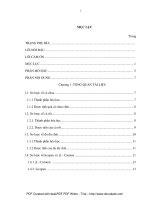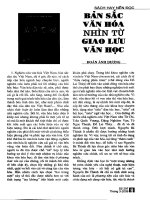Báo cáo sắc ký bản mỏng TLC (1)
Bạn đang xem bản rút gọn của tài liệu. Xem và tải ngay bản đầy đủ của tài liệu tại đây (2.64 MB, 38 trang )
TLC
Thin Layer chromatography
Which method can be used to evaluate an analyte based on a
titrant?
T
I
T
R
A
T
I
O
N
1. Principle
2. TLC technology
3. Rf value
4. Application
Outline
Principle
In TLC, components of the mixture are partitioned between
an adsorbent (the stationary phase, usually silica gel, SiO2)
and a solvent (the mobile phase) which flows through the
adsorbent.
Individual components move up at different rates, depending on
As the mobile phase rises up the TLC plate by capillary action, the
intermolecular forces between the component and the silica gel
components dissolve in the solvent and move up the TLC plate.
stationary phase and the mobile phase.
Principle
Analyte
Stationary phase
mobile
phase
Stationary phase
The stationary phase is a powdered
adsorbent which is fixed to a aluminum,
glass, or plastic plate.
They are polar stationary phase.
Which conclusions can be drawn from the
polarity of the stationary?
More polar analytes interact more strongly with the stationary
phase in move very slowly up the TLC plate.
More nonpolar analytes interact less strongly with the polar silica
gel and more strongly with the less polar mobile phase and move
higher up the TLC plate.
attached video ???
Mobile phase
The mobile phase is an organic solvent or a mixture of
organic solvents which is less polar than the stationary phase.
TLC technology
Deposition of the sample
Developing the plate
Identifying the spots
Deposition of the sample
How do you do for a good deposition ?
Video
Deposition of the sample
-
A small volume of sample will be dissolved in a volatile
solvent
- Using the capillary, deposited it close to the bottom of the
plate as a small spot (d = 1-2mm)
Developing the plate
Which steps do you do to develop the plate?
Video
Developing the plate
- The plate is placed in a glass developing chamber that contains a
small amount of the appropriate developing solvent
- The chamber is then covered
- The position at which the sample
above the level of the solvent
has been deposited must be
Identifying the spots
How do you visualize the spots?
Video
Identifying the spots
-
If there are any colored spots, circle them lightly with a pencil.
Most samples are not colored and need to be visualized with a
UV lamp (or iodine chamber, KMnO4 solution…).
Note
If the TLC plate runs samples which are too concentrated, the spots
will be streaked and/or run together. If this happens, you will have to
start over with a more dilute sample to spot and run on a TLC plate.
Rf value
The Rf value is the “ retardation factor” or the “ ratio-to-front” value
expressed as a decimal fraction.
The Rf value can be calculated as:
Distance run by the solute
x
Rf =
=
Distance run by the solvent front x o
Rf value
Rf = x1/xo
xo
x1
0 < Rf < 1
Example
1.
Calculate the Rf of 4 compounds.
2.
How many components are there in the unknown?
Solution
Rf (A) = 2/5 = 0.4
Rf (B) = 3/5 = 0.6
Rf (C) = 0.8/5 = 0.16
Rf (D) = 4/5 = 0.8
=> The unknown contains 2 compounds: C and B
Application
Analyzing the purity of a compound.
Following the course of a reaction.
Identification of components of a mixture (using appropriate
standards).









